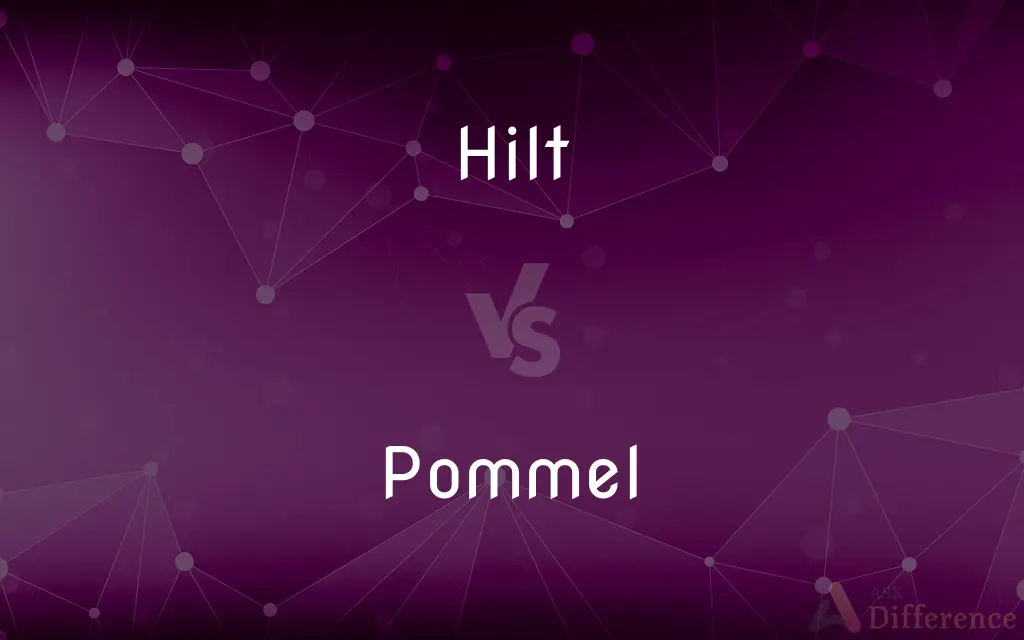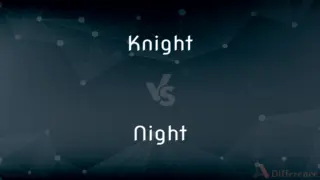Hilt vs. Pommel — What's the Difference?
Edited by Tayyaba Rehman — By Urooj Arif — Updated on April 5, 2024
The hilt is the handle of a sword, providing grip and balance, whereas the pommel is the knob at the sword's end, aiding in balance and control.

Difference Between Hilt and Pommel
Table of Contents
ADVERTISEMENT
Key Differences
The hilt of a sword is its handle, designed for the wielder to grip and control the weapon effectively. It includes several components such as the guard, grip, and pommel, each contributing to the sword's overall functionality and balance. On the other hand, the pommel is specifically the knob or cap located at the end of the hilt, which helps to counterbalance the blade's weight. This makes the sword easier to wield and can also serve as a striking surface in close combat.
While the hilt serves as the main interface between the sword and its user, offering protection to the hand with its guard component, the pommel primarily functions as a weight to ensure the sword is well-balanced. The pommel can be ornately designed, often reflecting the status or affiliation of the wielder, whereas the design of the hilt as a whole focuses on ergonomic handling and effectiveness in battle.
The construction of the hilt is crucial for the sword's overall performance, affecting how well a user can maneuver the blade. Materials and design vary widely to suit different fighting styles and preferences. Conversely, the pommel, while important for balance, offers more leeway in terms of design, often becoming a decorative element that does not significantly impact the sword's functionality beyond weight distribution.
In terms of historical significance, hilts have evolved to reflect the technological advancements and aesthetic preferences of various cultures and eras. They are integral to the identity of the sword types, such as the cross-guard of a medieval longsword or the complex basket-hilt of a Scottish claymore. The pommel, while also subject to stylistic changes, primarily remains a functional feature, with its evolution focused on improving the balance and ergonomics of the sword.
Both the hilt and the pommel are essential for a sword's balance and usability, their roles and impact on the sword's design and function differ significantly. The hilt affects the sword's handling and user protection, while the pommel's role is more focused on balance and can serve as an artistic statement.
ADVERTISEMENT
Comparison Chart
Definition
The handle of a sword, including guard, grip, and sometimes part of the pommel.
A knob or cap at the end of the hilt that helps balance the sword.
Function
Provides grip, protection, and contributes to balance.
Primarily balances the sword; can be used as a striking tool.
Components
Consists of a guard, grip, and sometimes integrates with the pommel.
Considered a separate component of the hilt.
Material
Can be made from wood, metal, leather, or other materials for comfort and durability.
Often made of metal to provide adequate weight for balance.
Significance
Affects the sword's handling and maneuverability.
Affects the sword's balance; often decorative.
Compare with Definitions
Hilt
The handle and guard of a sword, designed for gripping.
The knight’s hilt was adorned with rubies and gold, signifying his noble status.
Pommel
While primarily for balance, it is a part of the sword that can be personalized.
Choosing a pommel with a lion’s head, he added a personal touch to his sword.
Hilt
A critical aspect of a sword, impacting its overall functionality and aesthetics.
Craftsmen spent months designing the hilt to ensure it was both beautiful and functional.
Pommel
A component that can serve as a striking tool in close combat.
He used the pommel of his sword to stun his adversary in a clinch.
Hilt
A component of a sword that includes the guard, grip, and part of the pommel.
He held the sword by its hilt, feeling the balance between blade and handle.
Pommel
A counterweight at the sword’s hilt end, ensuring the weapon is well-balanced.
The pommel’s weight made the sword feel lighter and more manageable in his grip.
Hilt
The section of a sword that offers protection to the hand during combat.
The broad guard of the hilt shielded his fingers from enemy strikes.
Pommel
The knob or cap at the end of a sword’s hilt, aiding in balance.
The sword’s pommel was intricately engraved, adding to its elegance.
Hilt
The part of a sword that provides the wielder control over the blade.
The hilt’s design was ergonomic, fitting perfectly in the warrior’s hand.
Pommel
Often ornately designed, reflecting the status or affiliation of the wielder.
The pommel bore the crest of his family, marking the sword as an heirloom.
Hilt
The hilt (rarely called a haft or shaft) of a knife, dagger, sword, or bayonet is its handle, consisting of a guard, grip and pommel. The guard may contain a crossguard or quillons.
Pommel
To beat; pummel.
Hilt
The handle of a bladed weapon or tool.
Pommel
The upper front part of a saddle; a saddlebow.
Hilt
The handle of a sword, consisting of grip, guard, and pommel, designed to facilitate use of the blade and afford protection to the hand.
Pommel
Either of the two rounded handles on top of a pommel horse.
Hilt
(transitive) To provide with a hilt.
Pommel
A knob on the hilt of a sword or similar weapon used to provide a more secure grip on the weapon or to counterbalance the blade.
Hilt
A handle; especially, the handle of a sword, dagger, or the like.
Pommel
The upper front brow of a saddle.
Hilt
The handle of a sword or dagger
Pommel
A rounded knob or handle.
Pommel
Either of the rounded handles on a pommel horse.
Pommel
The knob on the hilt of an edged weapon such as a sword or dagger.
Pommel
A knob forming the finial of a turret or pavilion.
Pommel
The bat used in the game of knurr and spell or trap ball.
Pommel
(transitive) To pound or beat.
Pommel
A knob or ball; an object resembling a ball in form
Pommel
To beat soundly, as with the pommel of a sword, or with something knoblike; hence, to beat with the fists.
Pommel
A handgrip that a gymnast uses when performing exercises on a pommel horse
Pommel
Handgrip formed by the raised front part of a saddle
Pommel
An ornament in the shape of a ball on the hilt of a sword or dagger
Pommel
Strike, usually with the fist;
The pedestrians pummeled the demonstrators
Common Curiosities
How does the pommel contribute to a sword's balance?
The pommel acts as a counterweight to the blade, ensuring the sword is balanced and manageable.
Are the materials used for hilts and pommels different?
Yes, hilts may use a variety of materials for comfort and grip, while pommels are typically metal for proper weighting.
What is the primary function of a sword's hilt?
The hilt’s primary function is to provide a grip for the wielder, offering control and protection during use.
Do all swords have a pommel?
Most swords have a pommel, but the design and presence can vary depending on the type and era of the sword.
Is it possible to customize a sword's hilt?
Yes, sword hilts can be customized in terms of materials, design, and ergonomics.
Can the pommel of a sword be used as a weapon?
Yes, the pommel can be used as a striking tool in close combat situations.
Is the design of a sword's hilt important?
Yes, the design of the hilt is crucial for ergonomics, control, and protection in battle.
What does the decoration on a pommel signify?
Decorations on a pommel can signify the wielder's status, affiliation, or personal taste.
How can the pommel affect a sword's functionality?
By providing balance, the pommel makes the sword easier to wield and can affect striking capability.
Can the materials of a hilt affect a sword's performance?
Yes, the materials and construction of a hilt can greatly affect a sword’s handling and durability.
Why might a sword's pommel be ornately designed?
An ornate pommel can serve as a symbol of status or as part of the aesthetic appeal of the weapon.
Share Your Discovery

Previous Comparison
Knight vs. Night
Next Comparison
Scale vs. SupertonicAuthor Spotlight
Written by
Urooj ArifUrooj is a skilled content writer at Ask Difference, known for her exceptional ability to simplify complex topics into engaging and informative content. With a passion for research and a flair for clear, concise writing, she consistently delivers articles that resonate with our diverse audience.
Edited by
Tayyaba RehmanTayyaba Rehman is a distinguished writer, currently serving as a primary contributor to askdifference.com. As a researcher in semantics and etymology, Tayyaba's passion for the complexity of languages and their distinctions has found a perfect home on the platform. Tayyaba delves into the intricacies of language, distinguishing between commonly confused words and phrases, thereby providing clarity for readers worldwide.














































